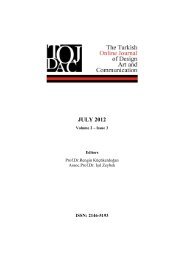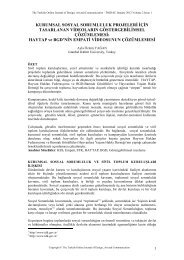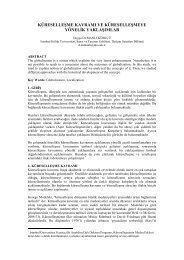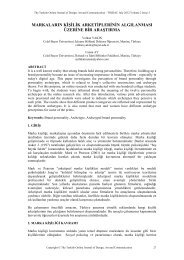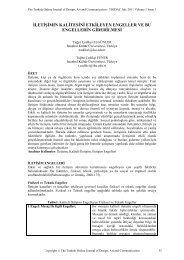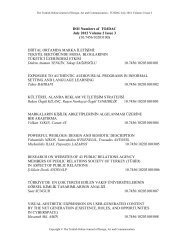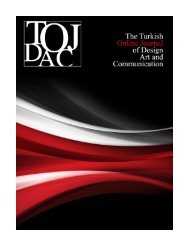aprıl 2012 - tojdac.org
aprıl 2012 - tojdac.org
aprıl 2012 - tojdac.org
You also want an ePaper? Increase the reach of your titles
YUMPU automatically turns print PDFs into web optimized ePapers that Google loves.
The Turkish Online Journal of Design, Art and Communication - TOJDAC April <strong>2012</strong> Volume 2 Issue 2<br />
UNDERSTANDING THE “HYBRID” MEDIA<br />
IN DESIGN EDUCATION<br />
Barı! AT"KER<br />
*Beykent University, Faculty of Fine Arts and Design, Istanbul, Turkey<br />
barisatiker@beykent.edu.tr<br />
ABSTRACT<br />
The digital transformation of moving images in the last 30 years has resulted with<br />
revolutionary impact on art and design fields. The increasing use of digital technologies for<br />
creating design and artwork with moving images has united many disciplines such as graphic<br />
design, photography, painting, cinematography, animation, three-dimensional visualization<br />
and typography, so that the moving image is no longer pure. According to Manovich, the<br />
combination of different disciplines within moving image has created a “hybrid” media where<br />
the different image layers are interacting with each other and this interaction is not only in the<br />
slight transition between different image layers, but also the transition between the production<br />
techniques and conceptual representations of them. The shifting from real to hybrid images<br />
provides many opportunities for creative solutions, but then the designer becomes more<br />
dependent on digital technologies. However the “hybrid” media and visual language should<br />
keep evolving and transforming as a combination of different disciplines, so that the design<br />
education perspective should move from software-based education to the new visual<br />
aesthetics. Thereby the creative solutions offered by the software will turn into new<br />
challenges and design experiences. This paper aims to explore the understanding of “hybrid”<br />
media’s visual language in design education through the frame of basic and new design<br />
principles.<br />
Keywords: Hybrid media, Design education, Visual language, Design principles<br />
1. INTRODUCTION<br />
“The hybrid or the meeting of two media is a moment of truth and revelation from which new<br />
form is born” [11]<br />
With the arise of personal computers and digital design technologies in the last quarter of 20 th<br />
century, the disciplines which described previously separate like cinematography, animation,<br />
graphic design, photography, typography and animation, have began to unite with the help of<br />
design software such as Adobe Photoshop, After Effects and Flash. According to Manovich,<br />
by the end of the decade, the “pure” moving-image became an exception and hybrid media<br />
became the norm. [10]<br />
The combinations of different disciplines, whether they are visible or not, resulted in<br />
unexpectedly because they were also combinations of different characteristics of different<br />
media types. Because the content of a new medium is some other older medium, there is a<br />
sense in which the new medium is a hybrid in that it possesses some aspects of the older<br />
media, which forms its content but presents it in a new context and hence creates new effect.<br />
[8] According to Davies and Parrinder, these combinations can be called articulated media,<br />
because the tempo and the nature of each media is distinct – even they are networked.<br />
Visualisations end up as objects in the world. [2] Long before the digital revolution on image<br />
creation, McLuhan has already stated the crossing or hybridization of the media release great<br />
new forces and energy by fission (as in literate media) and fusion (as in electric media) [11]<br />
It’s much more important to understand what will be the effects of using hybrid media in<br />
design education today. Because of many creative and artistic possibilities within the new<br />
media, we have to define the hybrid processes first.<br />
Copyright © The Turkish Online Journal of Design, Art and Communication 100



